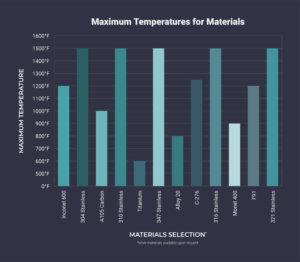Thermowells are a necessary component in many industries. Wake frequency calculations are critical for getting the right thermowell. A proper wake frequency calculation formula will ensure the thermowell will work correctly for your application.
Temp-Pro provides thermowell design solutions, including wake frequency calculations.
Our thermowell calculations ensure thermowells provide optimal operational performance. They follow the latest ASME PTC 19.3 TW-2016 standard for vibrations, which is a critical wake frequency for thermowelll design.
Our wake frequency calculations account for variables in fluid properties and pipe specifications. They consider data related to the thermowell itself, like its connection and mounting type. Engineers also need to know the bore, root and tip diameters.

What Are Wake Frequency Calculations?
Wake calculations help design engineers evaluate the construction and installation of thermowells. These calculations measure the data needed to evaluate thermowells under real-world operating conditions. They determine or prove the required dimensions and suitability of a thermowell.
A Closer Look at Wake Frequency
A wake is the area of recirculating flow right behind a solid body. It is also known as a Von Karman trail. When fluid flowing past a thermowell has a change in momentum, it creates a wake. Each wake has a specific frequency, which is a function of the diameter of the thermowell and the fluid velocity. This frequency is also called the vortex shedding frequency. Vortices form in the wake behind the thermowell, shedding from alternate sides. This creates two forces on the thermowell:
- Oscillating lift force, transverse to the media flow
- Oscillating drag force, in-line with the media flow
The vortex shedding frequency (wake frequency) is linear with the flow velocity. It’s inversely proportional to the thermowell tip diameter. The vortex forces cause the thermowell to vibrate.
The vibrations usually have a small magnitude. As the wake frequency approaches the natural frequency of the thermowell, vibrations increase. The thermowell goes into resonance when the wake frequency matches its natural frequency.
This vibration can cause mechanical failure of the well. The resonant frequency of the thermowell must be high enough that the fluid flow doesn’t create damaging vibrations.
Which Industries Use Wake Frequency Calculations?
Wake frequency calculations improve safety for plant operations. If the thermowell stem shears off, it could damage other equipment in the pipeline. Pipeline pressure could push the temperature measurement instrument out of the thermowell. This could cause a loss of pipeline fluid containment.
Wake frequency calculations have many applications, including:
- Chemical and petrochemical industries
- Onshore and offshore refineries
- Heat Recovery Steam Generators (HRSGs)
- Natural gas pipelines
Wake frequency calculations are important for applications with high process stress loads. Critical measuring locations also need them.

Thermowell Wake Frequency Calculations
Thermowell wake frequency calculations are generally conducted before the thermowell is manufactured. They ensure that the thermowell design can handle stresses from the process media. The wake frequency calculation data is available with the following basic parameters:
Velocity
The velocity of your process liquid affects forces like lift and drag that act on the thermowell. Velocity measurements are usually in feet per second or meters per second.
Density
Density can be mass per volume or specific gravity. The density and velocity have a combined effect.
Viscosity
Viscosity is the thickness of your process media. It measures how much resistance the liquid has to shear stress.
Maximum Operating Pressure and Temperature
The operating pressure and temperature of your media affect the thermowell stress level. Extreme temperatures and high pressure create a more demanding environment.
Thermowell Dimensions
The dimensions of the thermowell affect the wake frequency calculation. You’ll need information including:
- Bore diameter
- Thermowell root diameter
- Tip diameter
- Tip thickness
- Unsupported length
- Thermowell shielded length
The stem style is also important. Finally, the material the thermowell is made from affects the calculations.
Types of Stresses a Wake Frequency Calculation Considers
A wake frequency calculator takes four types of stresses into account. Each type of stress could cause the thermowell to fail. The thermowell must pass in all four areas to be acceptable for use in your application.
1. Frequency Limit
The resonance frequency of the thermowell has to be high enough that the process fluid flow won’t trigger damaging vibrations. The frequency of the thermowell needs to be higher than both the linear and transverse resonance frequencies.
2. Static Stress Limit
Hydrostatic fluid pressure and non-oscillating drag forces cause static stresses. The steady-state stress shouldn’t be more than what the thermowell can support. The Von Mises criteria determine the maximum allowable stress at normal fluid velocity for a thermowell.
3. Dynamic Stress Limit
Dynamic or oscillating stresses come from drag and lift forces. This stress must be less than the fatigue stress limit for the thermowell.
4. Hydrostatic Pressure Limit
The external pressure shouldn’t be more than the pressure rating of the thermowell at operating temperature. This applies to the thermowell tip, shank, and flange or threads.
Standards for Thermowell Wake Frequency Calculations
Temp-Pro follows ASME PTC 19.3 TW-2016, which is the latest standard for thermowell wake frequency calculations. The new standard replaces two earlier ones: ASME PTC 19.3 TW-1974 and ASME PTC 19.3 TW-2010.
ASME 1974 and 2010 Standards
The 1974 standard only applied to tapered profiles. It didn’t account for the stress from in-line resonance from oscillating-drag forces.
The 2010 standard used more advanced methods of calculation. It applied to tapered, straight, and reduced-tip thermowells.
ASME 2016 Standard
The new 2016 standard uses the most advanced methods available.
The 2016 standard applies to thermowells machined from bar stock. Tapered, straight, and reduced-tip profiles fall under the standard. Thermowells manufactured from pipe are outside its scope.
What if the Wake Frequency Calculation Isn’t What It Should Be?
Thermowell dimensions, material, and process mounting are the responsibility of the designer. A thermowell should have a wake frequency ratio of 0.8 or less. If a thermowell fails to meet the frequency, pressure, or stress requirements, changes to the dimensions or material may help. Possible alterations include:
- Increasing the support diameter
- Increasing the tip diameter
- Decreasing the bore size
- Using a stronger material
These modifications can create a passable solution.

Trust Your Wake Frequency Calculations to Temp-Pro
Wake frequency calculations for thermowells, and frequency ratio formulas are critically important to the safety of your facilities and personnel. They help ensure your operations are at their optimal levels.
Temp-Pro has been serving clients since 1972. We consider a complete set of variables, which results in a concise technical report with results and observations.
Contact us today to discuss your thermowell sizing, calculation, and project needs.



